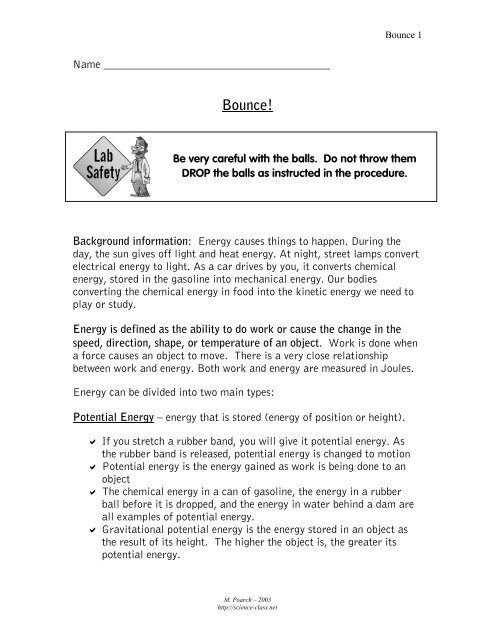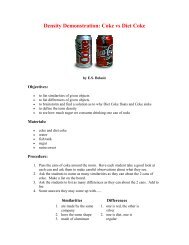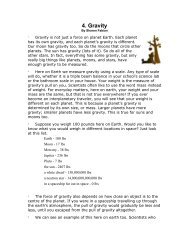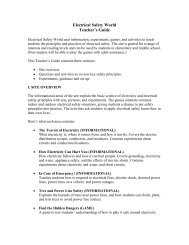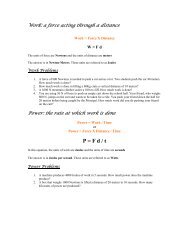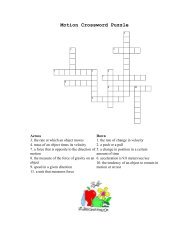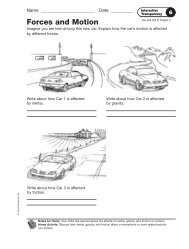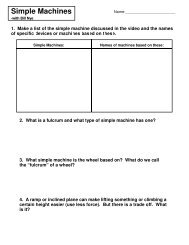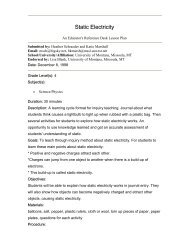Bounce! - Science Class
Bounce! - Science Class
Bounce! - Science Class
Create successful ePaper yourself
Turn your PDF publications into a flip-book with our unique Google optimized e-Paper software.
<strong>Bounce</strong> 1<br />
Name ________________________________________<br />
<strong>Bounce</strong>!<br />
Be very careful with the balls. Do not throw them<br />
DROP the balls as instructed in the procedure.<br />
Background information: Energy causes things to happen. During the<br />
day, the sun gives off light and heat energy. At night, street lamps convert<br />
electrical energy to light. As a car drives by you, it converts chemical<br />
energy, stored in the gasoline into mechanical energy. Our bodies<br />
converting the chemical energy in food into the kinetic energy we need to<br />
play or study.<br />
Energy is defined as the ability to do work or cause the change in the<br />
speed, direction, shape, or temperature of an object. Work is done when<br />
a force causes an object to move. There is a very close relationship<br />
between work and energy. Both work and energy are measured in Joules.<br />
Energy can be divided into two main types:<br />
Potential Energy – energy that is stored (energy of position or height).<br />
If you stretch a rubber band, you will give it potential energy. As<br />
the rubber band is released, potential energy is changed to motion<br />
Potential energy is the energy gained as work is being done to an<br />
object<br />
The chemical energy in a can of gasoline, the energy in a rubber<br />
ball before it is dropped, and the energy in water behind a dam are<br />
all examples of potential energy.<br />
Gravitational potential energy is the energy stored in an object as<br />
the result of its height. The higher the object is, the greater its<br />
potential energy.<br />
M. Poarch – 2003<br />
http://science-class.net
<strong>Bounce</strong> 2<br />
There is a relationship between the mass of an object and its<br />
gravitational potential energy. The more massive an object is, the<br />
greater its potential energy.<br />
Kinetic Energy – energy that is moving, (energy of motion).<br />
A rubber band flying through the air has kinetic energy, a bouncing<br />
ball has kinetic energy, and you have kinetic as you are walking to<br />
class.<br />
Kinetic energy is related to both mass and speed. The greater the<br />
mass or speed of an object, the greater the potential energy.<br />
Kinetic energy is the energy released by an object as it is doing work<br />
Even when an object seems to be at rest, its atoms and molecules<br />
are in constant motion and thus have kinetic energy. The average<br />
kinetic energy of the atoms or molecules is measured by the<br />
temperature of the body.<br />
Kinetic energy comes In different forms - There are different forms<br />
of kinetic energy. When we turn on a lamp, electrical energy gives<br />
us light. When we start a car, mechanical energy takes us from<br />
home to school. When we build a campfire, heat (also called<br />
thermal) energy roasts our marshmallows. And, when we eat the<br />
marshmallows, the chemical energy from carbohydrates fuels our<br />
bodies.<br />
Different forms of kinetic energy can be changed into other forms.<br />
Kinetic energy, as well as other forms of energy, can be transferred<br />
from one object to another. When energy is transferred or changes<br />
form, the total amount of energy stays the same. Energy cannot be<br />
created or destroyed.<br />
Potential energy is converted into kinetic energy.<br />
For example – A waterfall has both potential and kinetic energy. The<br />
water at the top of a waterfall has potential energy. When the water<br />
begins to fall, its potential energy is changed into kinetic energy. This<br />
change in energy happens at Niagara Falls where it is used to provide<br />
electricity from the transformation of mechanical and electromagnetic<br />
energy to parts of the northeastern United States.<br />
It does not take much effort to lift a ball off the ground. However, work is<br />
being done to the ball as it is being lifted, giving it energy. When the ball<br />
M. Poarch – 2003<br />
http://science-class.net
<strong>Bounce</strong> 3<br />
is dropped, the ball begins to move. The potential energy is converted into<br />
kinetic energy.<br />
For example:<br />
http://questions.science.nus.edu.sg/Book/node3.html#SECTION00313000000000000<br />
Energy is conserved. When you drop a ball, the potential energy is<br />
changed into kinetic energy. When the ball bounces to a lower and lower<br />
height, it is not losing energy. As the falling ball rubs against the air,<br />
some of the kinetic energy is changed into heat. Some energy changes into<br />
sound when the ball hits the floor. Because some energy becomes unusable<br />
when it changes from one form to another, the ball will never have enough<br />
energy to bounce back up to its starting height. In any conversion of<br />
energy, some of the energy becomes unavailable for future<br />
use. Energy can be neither created nor destroyed, but it can<br />
be converted from one form to another and it can be<br />
transferred from one object to another. You can't ever get<br />
as much energy out of a transformation as you put into it.<br />
M. Poarch – 2003<br />
http://science-class.net
<strong>Bounce</strong> 4<br />
Problem: To observe the relationship between potential and kinetic<br />
energy.<br />
Materials:<br />
Small rubber ball Meter stick 3” wide masking tape<br />
Pen<br />
Procedure:<br />
1. Starting at the floor, stretch the tape vertically against the wall or<br />
table leg.<br />
2. Draw lines across the tape to mark ½ meter (50cm), ¾ meter<br />
(75cm), and 1 meter (100 cm) above the floor.<br />
3. Hold the ball at the ½ meter mark and drop it. Observe carefully as<br />
the ball bounces.<br />
4. Mark the height of the bounce on the tape.<br />
5. Use the meter stick to measure the height of the bounce and record<br />
it in the data table.<br />
6. Repeat steps 3 – 5 for a total of 5 trials.<br />
7. Hold the ball at the ¾ meter mark and repeat steps 3 – 6.<br />
8. Hold the ball at the 1 meter mark and repeat steps 3 – 6.<br />
Data:<br />
<strong>Bounce</strong> Height<br />
Starting<br />
Height Trial 1 Trial 2 Trial 3 Trial 4 Trial 5<br />
50 cm<br />
75 cm<br />
100 cm<br />
Average<br />
<strong>Bounce</strong><br />
Height<br />
M. Poarch – 2003<br />
http://science-class.net
<strong>Bounce</strong> 5<br />
Data Analysis:<br />
Make a bar graph to compare the average bounce height at different<br />
starting heights. Remember to title and label your graph.<br />
What patterns or relationships do you see in the data<br />
_____________________________________________________________<br />
_____________________________________________________________<br />
_____________________________________________________________<br />
M. Poarch – 2003<br />
http://science-class.net
<strong>Bounce</strong> 6<br />
Questions: (use your textbooks if necessary)<br />
1. Describe energy:<br />
________________________________________________________<br />
________________________________________________________<br />
________________________________________________________<br />
2. Describe potential energy:<br />
________________________________________________________<br />
________________________________________________________<br />
________________________________________________________<br />
3. Describe kinetic energy:<br />
________________________________________________________<br />
________________________________________________________<br />
________________________________________________________<br />
4. When is work being done in this investigation<br />
________________________________________________________<br />
________________________________________________________<br />
________________________________________________________<br />
5. When did the ball have the most potential energy in this<br />
investigation Explain your answer.<br />
________________________________________________________<br />
________________________________________________________<br />
________________________________________________________<br />
________________________________________________________<br />
6. How were you able to increase the amount of potential the ball had<br />
________________________________________________________<br />
________________________________________________________<br />
________________________________________________________<br />
M. Poarch – 2003<br />
http://science-class.net
<strong>Bounce</strong> 7<br />
7. Explain another way to increase the amount of potential energy in<br />
an object:<br />
________________________________________________________<br />
________________________________________________________<br />
________________________________________________________<br />
________________________________________________________<br />
8. How is the potential energy in the ball changed to kinetic energy in<br />
this investigation<br />
________________________________________________________<br />
________________________________________________________<br />
________________________________________________________<br />
________________________________________________________<br />
9. How is kinetic energy in the ball changed back to potential energy<br />
in this investigation<br />
________________________________________________________<br />
________________________________________________________<br />
________________________________________________________<br />
________________________________________________________<br />
10. Not all of the ball’s potential energy was converted into<br />
kinetic energy. Where did this energy go<br />
________________________________________________________<br />
________________________________________________________<br />
________________________________________________________<br />
________________________________________________________<br />
M. Poarch – 2003<br />
http://science-class.net
<strong>Bounce</strong> 8<br />
11. Give an example of potential energy in nature:<br />
________________________________________________________<br />
________________________________________________________<br />
________________________________________________________<br />
12. Give an example of kinetic energy in nature:<br />
________________________________________________________<br />
________________________________________________________<br />
________________________________________________________<br />
13. Describe a situation when a lever has potential energy:<br />
________________________________________________________<br />
________________________________________________________<br />
________________________________________________________<br />
14. Describe a situation when a pulley has kinetic energy:<br />
________________________________________________________<br />
________________________________________________________<br />
________________________________________________________<br />
15. A basketball player throws a ball into the air and catches it<br />
before it hits the ground. Label where the ball has potential energy,<br />
kinetic energy, and two different energy conversions.<br />
M. Poarch – 2003<br />
http://science-class.net


